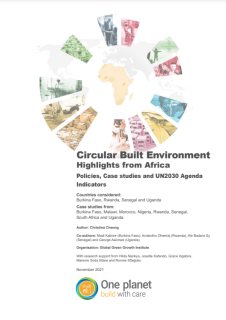
Population growth and urbanization in the African region are expected to continue at the current high rates over the coming decades. The corresponding demand for housing and public infrastructure from this growth is challenged by the depleting natural resources, climate change induced weather impacts and the urgent need to switch from carbon intensive means of infrastructure provision. Circularity provides a holistic opportunity for the industry to switch from a cradle to grave planning towards maximizing the longevity of resources, primarily materials, energy and water.
This report focuses on four countries in Africa, Burkina Faso, Rwanda, Senegal and Uganda. Through policy analysis and stakeholder interviews, it presents the operating context for the building industry in these countries. While the conception of circularity has not been formally developed and communicated in the focus countries, the research team found strong examples demonstrating circularity throughout all phases of the building life cycle.
Nineteen of these examples are featured as case studies in this report and provide insights to the current initiatives on circularity in buildings. Case studies featured also include projects and practices from Malawi, Morocco, Nigeria and South Africa.
